|
IN
THE BEGINNING...
Immigration
The
history of the immigration of the Polish people to America shows that
the greatest percentage of this national group came to the United States
in the year 1870. Statistics indicate that in the year 1900 there were
over 383,000 Poles, and by 1913, the number exceeded two million. The
immigrants came to this country for various reasons. Perhaps the most
pressing situation was the threefold partition of Poland, during which
her children came under the rule of three foreign powers: Prussia, Austria
and Russia. While living under these powers, the Polish people faced
many and severe persecutions. Many of them, therefore, to avoid this
oppression, and especially for religious reasons, fled their homeland
and migrated to other parts.
Many
of the immigrants who had to leave their homeland for peace of mind
and peace of conscience came from the towns and villages. They were
accustomed to hard work, but they could not always find even the most
unspecialized work. One of their handicaps, of course, was their inability
to speak the English language. At times they were discriminated against,
presenting another difficulty. With the help of the immigration departments
and special employment and placement bureaus, they were able to find
work in factories, hotels, private homes and especially on the farms.
The numerous farms in the area was a prime reason that so many settled
in the vicinity of Riverhead. The records of birth and marriage it the
Riverhead Town Hall for the beginning of the 20th Century show that
most immigrants to Eastern Long Island were engaged in farming.
back
to top
The
Pioneer Families
In 1886, a Polish immigrant named Francis Kruszewski settled in Riverhead
with
his wife Regina, being
perhaps the first polish immigrant to Riverhead; he only stayed there
three years. He moved to Bridgehampton in November of 1889, and finally
settled in Southampton in 1890. He would be one of the founding members
of the Polish Community and Parish "Our
Lady of Poland" in Southampton. That church opened in 1918 so that
Polish immigrants would not have to travel the long distances to Riverhead
for Polish mass, as did all of the 331 Polish families betweeen Remsenberg
and Montalk up until 1918. They came by railroad, horse and buggy, and
bicycle to receive the Sacraments of the Church from Pastor, Father
Rysiakiewicz.
One
of the next families to have settled in the Riverhead area, according
to the records of the Riverhead Town Hall (which only date as far back
as 1881) was a Cacleski Family. "Cacleski" may be a misspelling of the
name Sendlewski;
for, upon checking the Baptismal records of St. John's Church in Riverhead,
which date back to 1879, we find a person of this family being baptized
under the name of Veronica Sendlewski. Veronica Sendlewski was born
on March 5, 1888. This was verified by Mr. Thomas Sendlewski, Sr., a
member of the Parish and a brother to Veronica. He was born the following
year in Setauket. His father, Andrew Sendlewski, was at that time employed
by Henry Howell, a farmer.
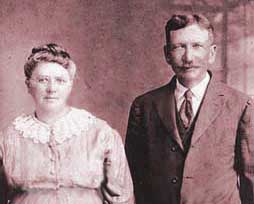
Early
Parishioners Michalena and Antoni Kuźniewski
Antoni
Kuzniewski, the son of Gabryel and Katarzyna Kuzniewski, emigrated in
1890 from Mala
Wies, Plocka Gubernya, Polish Russia to Flushing, New York. His
wife Michalena and son Adam followed in 1891.
They later moved to Bayside and then Calverton sometime before 1907
following the wave of Polish immigration eastward. Their son, John Kneski,
baptized Jan Kuzniewski, received the Sacrament First Holy Communion
in St. Isidore's Parish in 1914 by Ks. Stanislaw Rysiakiewicz, mentioned
below in the 1962 history text. Link
to the Kuzniewski Genealogy Website

Jan
Kuzniewski's First Holy Communion Certificate,*
from 1914. Records were officially kept from
1904 according to the 1962 church history publication. The church is in
desperate need of a volunteer historian and an archives assistance mechanism
after 100 years of history.
In
conversation with the older residents of Riverhead and members of St.
Isidore's Parish, it was established that among the first 'colonists'
of Polish birth were Ignatius Ruszkowski and Joseph Przyborowski. They
were the first to have purchased their own farms. Others who followed
were: Frank Fafinski, Adam Danowski, Antone Danowski and John Danilowicz.
Prior to 1900 there are still other Polish names appearing in the local
records. Among these are: Joseph Stijecki, Antone Fafinski, Matthew
Kruszeski, Adam Mackiewicz, Michael Kujan, Antone Palembas, Joseph Zawieska
and Antone ,Zawieska. There are many other names, familiar to us today
in this vicinity, which also appear in the records. They are: Alexander
Rolle, Martin Panewicz, Peter Panewicz, John Romianski, John Rykaczewski,
John Rogozinski, Lawrence Bakowski, John Tylicki, Bernard Balser, Stanley
Gaura, Louis Tyska, Joseph Malinowski, Joachim Orlowski, Frank Haupt
(Opcinski), Antone Sidor, Joseph Cybulski, Joseph Filmanski, George
Nauwialis, Valenty Adamczewski, Joseph Choenski, W. Polakiewicz and
Michael Wojciechowski. There may have been others, but these were the
ones available from local records. We might mention that the widow
of one of the above mentioned is still living today, being 98 years
of age, Mrs. Anna Kujan, wife of Michael Kujan.
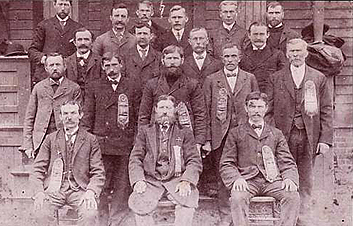
THE
SAINT ISIDORE SOCIETY
The
Pioneer Society of the Parish. Through the efforts of this earnest group
of men who organized officially on October 14, 1895, the immigrants'
wish for their own Polish Roman-Catholic Parish was realized. From left
to right - First row: John Liszewski, Joseph Przyborowski, Isadore Rosko.
Second row: John Romianski, Bruno Panewicz, Ignatius Ruszkowski, Anthony
Fafinski, Andrew Sendlewski. Third row: Joseph Kliniewski, Joseph Filmanski,
John Rykaczewski, Julius Kusiel. Fourth row: Joseph Szuler, Lawrence
Ronkowski,, Bernard Balser, Andrew Sendiewski, John Romianski, John
Sendiewski.
Back
to top
The
Seed for the Parish is Planted
Shortly
after these people had settled in this vicinity, the men began to organize
themselves into a Polish Fraternity bearing the name "'Towarzystwo Polskie
Rzymsko-Katolickie Bratniej Pomocy pod Opieka Sw. lzydora, Patrona Rolnikow
~The Polish Roman-Catholic Society of Fraternal Assistance under the
Patronage of St. Isidore, the Patron of Farmers." The first meeting
of this Society was held in the home of Mr. Frank Fafinski. By March
14, 1895, they had formulated their constitution, the committee consisting
of Messrs. Joseph Przyborowski, Marian Wiktorowicz and Bruno Pitnewicz.
The official date of the organization of the Society of St. lsidore
is given as October 14, 1895. Its first board of officers consisted
of: Ignatius Ruszkowski, President: Isidore Rosko, Vice-president; Andrew
Sendlewski, Treasurer; John Liszewski, Secretary. 'The photograph included
in this book shows that their original membership was approximately
twenty. Those missing from the photograph are: Frank Fafinski, John
Danilowicz and Marian Wiktorowicz.
Although
this Society had, as one of its objectives, the joining together in
fellowship so as to bring help to those who needed it among their members,
their widows and families, they were insistent upon organizing a Polish
Roman Catholic Parish. At the time, they were attending St. John's Parish
in Riverhead. In fulfilling their obligation of hearing Mass on Sundays
and Holy Days in St. John's Church, they missed hearing the Gospel of
Christ and His teachings in their own native tongue. Provision was made
for them to receive the Sacrament of Penance twice a year when a certain
Father Baran came from Newtown, New York. Even though their needs were
being satisfied in a minimal sense, they felt they would be more content
with a parish of their own, in which they could have all that they needed
and desired spiritually in their own native tongue.

POSTER
announcing the Blessing of the Cornerstone for the new
St. Isidore's Church on November 4, 1906.
Photo in upper left corner depicts the original St. Isidore's Church,
a former schoolhouse called "The Academy", where the First
Mass was offered in 1903.

THE
CEREMONIES
connected with the Blessing of the Cornerstone of the
new Church. Clergy
are, left to right: Rev. Louis P. Muszynski, Pastor;
Rev. Boleslaus Puchalski, Polish Preacher; Rev. L. Kwasniewski, English
Preacher; Rt. Rev. Msgr. P. J. McNamara, Vicar-General of the Diocese
of Brooklyn. In the background is Mr. Cielesik, the organist.
With
the help of a Mr. Ruzicki from Newtown, N.Y. and through their own untiring
efforts, they purchased a piece of property on which stood the Academy,
the first schoolhouse ever built in Riverhead. This parcel of land was
located on Cemetery Road (now Pulaski Street) bounded by Marcy Avenue
and Sweezy Avenue. 'This parcel and building, which was to become the
first St. Isidore's Church, was purchased at a cost of $53,000.
'Through
the efforts of these pioneers, the seed was sown for the largest Polish
Roman-Catholic Parish on the eastern end of Long Island. A great deal
of recognition and respect is due these men who labored so hard to organize
this wonderful parish that is ours today.
St.
Isidore's Parish was canonically erected in 1903. It was in this year
that the First Mass was offered in the school building, which was purchased
by the St. Isidore's Society. Even though the canonical date for the
erection of the Parish is 1903, the parish records date back only to
1904, because a permanent pastor was not assigned to the Parish at that
time. During the first two years of its existence, Redemptionist and
Franciscan Fathers traveled weekends to minister to the faithful. Among
these our records re veal such names as Fathers F. Jasinski and F. Supik
of the Redemptionist Fathers. Among the Franciscan Fathers (Order of
the Friars Minor, Conventual) , we find Fathers P. Topolski, C. Rybinski,
Stanislaus Lepich and F. Wilk.

An
early photo of St. Isidore's Choir under the patronage of St. Cecilia.
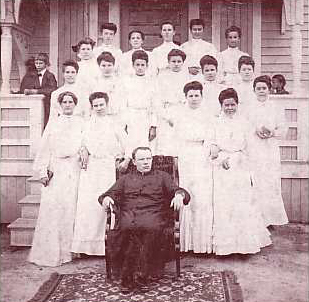
The
Young Ladies of the Parish,
shown here with Father Muszynski, were drawn together early in
Parish history through their Sodality of the Blessed Virgin, organized
December 8, 1904.

ST.
ISIDORE'S CHURCH
as if appeared upon its completion and dedication on
September 19, 1907.

THE
ORIGINAL CHURCH,
once
a schoolhouse, which was converted info the rectory upon completion
of the new Church in 1907.
This venerable building served as a rectory until if was dismantled
in September, 1957.
Back
to top
First
Resident Pastor
The
first resident Pastor, assigned to the Parish in March of 1905, was
Father Louis P. Muszynski. Shortly after his arrival, the parish really
began to take shape. One of the first projects undertaken by Father
Muszynski was the building of the present Church, which began somewhere
near the end of 1905, or at the beginning of 1906. In order to break
ground for the new St. Isidore's Church, the temporary Church (the schoolhouse)
had to be moved to a site immediately adjacent on the corner of Cemetery
Road (Pulaski Street) and Marcy Avenue, which at that time was merely
a narrow dirt path. During the period of construction, this temporary
Church also served as the rectory where the Pastor took tip his residence.
'There
is in our possession a placard which announced the blessing of the cornerstone
on Sunday, November 4, 1906. 'The blessing was executed by the Right
Reverend P. J. McNamara, who at that time was Vicar General of the Diocese
of Brooklyn. The sermon was preached in the Polish language by Father
Boleslaus Puchalski, Pastor of Our Lady of Czestochowa Parish in South
Brooklyn. The English sermon was preached by Father L. Kwasniewski,
Pastor of St. Adalbert Parish in New York.
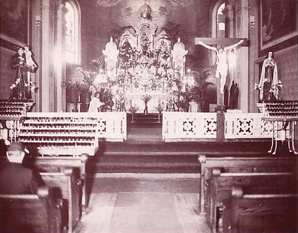
The
Interior of the Church,
as it appeared during the Pastorate of Father Charles F. Schimmel, on
the occasion of the Forty Hours Devotion. Father Schimmel is kneeling
in the Sanctuary and Mrs. Konstantia Lewandowski in the pew.
The
building of the Church took approximately one whole year, since the
date of the dedication of the church was September 19, 1907. Father
Muszynski must have been a man of great foresight in constructing a
church of such proportions when the congregation was comparatively small.
To this day, the Church has been adequate for all the faithful of the
parish.
The
number of parishioners began to increase. Poles from all sections began
to join in the ranks of the parishioners. We have proof of this from
the various memorials in the Church. Two of the Stations of the Cross
were gifts from "The Polish" People of Southampton" and "The Polish
People of Patchogue." Others came to St. Isidore's by train front such
places as Orient, Manorville, Cutchogue and other points along the main
line of the railroad. A good number of people came from Speonk, Westhampton
and Eastport.
According
to the Baptismal records of the Parish, the first person to have received
the Sacrament of Baptism in St. Isidore's Parish was Anna Gwozda, the
daughter of Basil and Mary Bialochlawek. She was born on February 24,
1904, and was baptized on February 28th. The priest who administered
the Sacrament of Baptism was Father Patrick Topolski, O.F.M., Conv.
The second Baptism recorded was of Martha Zaluski, dated as March, 1904.
'The
first to have entered into the holy bonds of Matrimony in St. Isidore's
were Joseph Kazmierczyk and Victoria Dzielak on April 25, 1904. The
officiating priest was Father F. Wilk. The second marriage was between
Peter Borodenko and Anna Jasinski on August 14, 1904, in the presence
of Father Rzesutek. The
first recorded burial was that of Alexander Tamulewicz, 36 years of
age. The burial took place on January 23, 1905.
The
Pastors of St. Isidore's Parish in chronological order were:
Rev. Louis P. Muszynski, 1905-1909
* Rev. Stanislaus Rysiakiewicz, 1909-1917
Rev. Charles F. Schimmel, 1917-1942
Rev. Edward Belaus - Administrator, 1942
Rev. Ceslaus S. Biedrzycki, 1942-1952
Rev. Walter Tomecki - Administrator, Nov. 1952-Jan. 1953
Rt. Rev. Msgr. Anthony F. Zasowski, 1953-1962
Rev. John J. Mirecki - Administrator, May 1962
Those
who served in the capacity of Assistant:
Pastor were: Rev. Wladyslaw Manka, 1909-1913
Rev. Edward F. Belaus, 1939-1943
Rev. Matthew J. Wisniewski, 1943-1946
Rev. Wenceslaus S. Grochowski, 1946-1952
Rev. Wladyslaw Samolewicz, 1952-1954
Rev. Walter J. Tomecki, 1952-1953
Rev. Vetold Pupin, 1953
Rev. Alfred J. Markiewicz, 1953-1961
Rev. Vincent J. Skiba, 1954-1955
Every
Pastor in the history of St. Isidore's has contributed his share to
the development of the parish. Father Muszynski, the first Pastor, indeed
laid the ground work and each of the others built upon it. There is
no doubt that a great deal was accomplished in the pastorate of the
late Rt. Rev. Monsignor Anthony F. Zasowski.
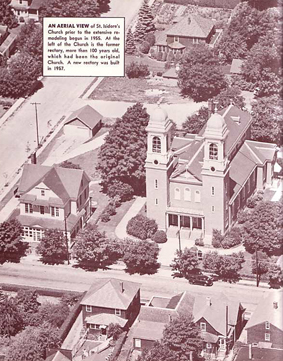
AERIAL VIEW
of St. Isidore's Church prior to the extensive remodeling
begun in 1955. At the left of the Church is the former rectory, more
than 100 years old, which had been the original Church. A new rectory
was built in 1957.
As
with all buildings, so also with Parish buildings, there is need from
time to time for repair and even replacement. 'The most significant
changes in the history of St. Isidore's began with the remodeling of
the Church in 1953 when, under the pastorate of Monsignor Zasowski,
the Church was completely repainted, a new organ and heating system
installed and all the stained-glass windows releaded. Along with this,
Monsignor also improved the landscaping of the parish grounds as we
see it today. A few years later, automatic bell ringers were installed
to make easier the announcement of Divine Services and the ringing of
the traditional Angelus at 6 A.M., 12 Noon and 6 P.M.
One
of the first great building projects undertaken by Monsignor, during
his pastorate, was the building of a new rectory. The old rectory was
the original Church, which became the residence of the priests of the
Parish. It was necessary to replace this with a new, building because
the other, badly in need of repair, and being about 100 years old, proved
too costly to renovate or rebuild. Construction on the present rectory
began in May of 1956, and on May 1, 1957, the priests of the Parish
took tip residence in this beautiful and very practical home. In September
of that year, much to the regret of all, the original St. Isidore's
Church - Rectory was necessarily torn (to make room for the spacious
green lawn and the approach to the front door of the new rectory.
Continuing
with the plan to beautify St. lsidore's, a few years later the parking
area, which in times of rain and snow became a field of mud, was blacktopped
and made more convenient to those who would then and in the future attend
St. Isidore's Church. Today, it is possible to park many more cars than
ever in the parking area of the Church. We can all, today, be
justly proud of our Parish because it is truly one of the most beautiful
in this area.
Much has been said about
the material aspects of St. Isidore's development. It is not possible,
however, to speak quite as factually about the spiritual development.
These facts and figures are known only to God. We are confident, though,
that the fruits of the spiritual ministrations of the priests of the
parish and the efforts of the faithful have caused many of our former
parishioners to be in the presence of God today where, says St. Augustine,
we find our true peace.
back
to top
Early
Parish Organizations
There
is a saying which states that the beginnings are always the most difficult.
There is much truth in this statement, as the pioneers of St. Isidore's
had experienced. Though they themselves had very little and had to work
exceedingly hard to make a living; nevertheless, they were able to organize
themselves to form their own parish. These individuals worked together
for the good of the parish as well as their own well-being. Each knew
of the difficulties the other had to cope with and tried to help. This
was again made possible through their close attachment and affection
for their parish.
Every
parish has certain organizations or societies. This was true also in
the history of St. Isidore's. We saw previously that through the efforts
of a society, which predates the parish itself, this parish became a
reality. This great group was the St. Isidore Society. Shortly
after the organization of the parish, other societies began to form.
The Parish, of course, did not consist only of men. There were also
their wives and children. They also wanted to congregate and to feel
more attached to their parish and their priests.
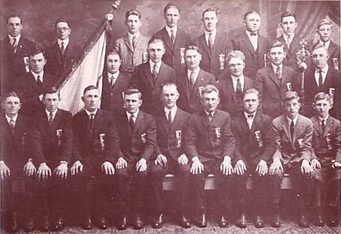
Members
of the St. Stanislaus Kostka Society,
a group of boys and young men organized fully by April
23, 1905.
In January of 1956, it was reorganized into the St. Isidore's Junior
Holy Name Society.
Full
of enthusiasm, the women organized into The Rosary Society. Their official
date of aggregation to the Archconfraternity of the Rosary is March
12, 1905. The youth, following the example of their parents, also began
to organize. The boys and young men started a group of their own under
the title of the St. Stanislaus Kostka Society. They were organized
fully by April 23, 1905. The girls and young women, by December 8, 1904,
formed their Sodality of the Blessed Virgin (The Children of Mary).
In
the meantime, another fraternity of men appeared on the scene. This
was the St. Joseph Society, organized on April 9, 1905. Unfortunately,
this Society no longer exists today. Approximately three years ago,
having only a handful of its members surviving, the Society disbanded.
In those early years of St. Isidore's, one more fraternity was organized
consisting of both men and women: The Archconfraternity of the Sacred
Heart or the Apostleship of Prayer. It takes its beginnings as of September
28, 1905. In 1918, the Third Order of St. Francis was organized.

Members
of the St. Joseph Society,
photographed
July 30, 1911. This society, organized April 9, 1905, and no longer
in existence, was another one of the early groups instrumental in developing
close parish ties. Antoni Kuźniewski, my great-grandfather, is top row
center, in front of the flag.
Almost
twenty-one years elapsed before any new societies or organizations appeared
in the annals of St. Isidore's. In 1939, the St. Isidore's Holy Name
Society and the Altar - Rosary Society were organized. Today, these
are perhaps the most active of all the societies. After some time,
the Sw. Stanislaus Kostka Society became inactive and, in fact, almost
defunct. In January of 1956 it was, therefore, reorganized into the
St. Isidore's junior Holy, Name Society. The
parish consists of many souls. Not all of hem join the societies under
parochial auspices. Others join, besides these, their national or patriotic
societies which meet within the confines of the parish. These, we might
say, take their origin indirectly through the parish.
Near
the very beginning of the foundations of the Polonia in the Riverhead
area, there arose, in 1904, a dramatic society. Proud of their ancestry
and, in most cases, their native culture, the men and women organized
what was called the Dramatic Circle (Kolo Dramatyczne) . Their chief
aims were to take an active part in uplifting the Polish Spirit and
the Polish language. One of their activities consisted in presenting
theatrical plays and skits in Polish. This organization has since ceased
to exist. A
nonpolitical group was organized in 1908 bearing the name of "The Riverhead
Polish Independent Club". It was through the efforts of this organization
throughout the years that we have had a Polish Hall in Riverhead, where
many of our parish activities have taken place. The Women's Auxiliary
was formed in 1929.
Locally,
during the year of 1917, there was organized also a group of men who
are popularly known as "Rolniki", literally translated, "The Farmers".
Its official name in English is the Agricultural and Commercial Society
of Riverhead. Yet another group, indirectly connected to St. Isidore's
Parish, is the local unit of the Polish National Alliance, known here
as Group #2691. It is also known as the Society of Casimir Pulaski.
It marks its beginning in 1932.
Many
significant events -have taken place in the history of St. Isidore's
since its founding. Here are presented the earlier facts which truly
constitute the foundations of the parish. There are many alive today
who cherish many thoughts about their parish. There are many who through
varied circumstances have left the confines of the parish but are still
with us in spirit.
back
to top
Vocations
St.
Isidore's has been blessed in many ways. One of the greatest blessings
was through one of her native sons who is now a member of the hierarchy
of the Church. This native son is the Most Reverend Alexander M. Zaleski,
D.D., presently an Auxiliary Bishop and Vicar General of the Archdiocese
of Detroit. Bishop Zaleski was ordained July 12, 1931, in Belgium. He
offered his first Solemn Mass in St. Isidore's Church shortly upon his
return from Louvain. He received the fullness of the priesthood, through
the Episcopal Consecration, on May 23, 1950. Our Parish, being justly
proud of Bishop Zaleski, honored him with a banquet on July 29, 1956,
on the occasion of his Silver Jubilee in the Priesthood. Bishop Zaleski
is presently Pastor of St. Alphonsus Parish in Dearborn, Michigan.
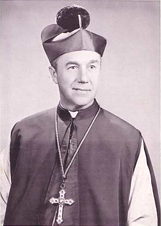
Most
Reverend Alexander M. Zaleski, D.D.
( Brother of my grandfather, Stanley Doroski, an asparagus
farmer of Riverhead)
Others
of our native sons who have been called by God to the Holy Priesthood
are: The Reverend Joseph C. Kazmierczyk, ordained in 1932 for the Diocese
of Syracuse in New York; The Reverend Leon L. Adamcewicz, O.S.B., ordained
May 31, 1940, for the Order of St. Benedict. Father Leon Adamcewicz
offered his First Solemn Mass in St. Isidore's Church on June 9, 1940.
He has since been called to his eternal reward. A third son of St. Isidore's
in the Priesthood is the Reverend Francis Filmanski, ordained June 6,
1953. He offered his First Solemn Mass in St. Isidore's the following
day and has since been assistant pastor at Our Lady of Poland in Southampton.
St.
Isidore's has also given two daughters to the Church. These are Genevieve
Macksel and Lottie Kruk. Genevieve Macksel entered the Dominican Sisters
of the Sick Poor in 1932 and was professed in 1957. She is presently
assigned to their Motherhouse on Henry Street in Brooklyn. Her name
in Religion is Sister Mary Trinitas. Lottie Kruk entered the Congregation
of St. Felix (C.S.F.) in 1921 and was professed in 1925. She is known
in Religion as Sister Mary Pudenciana and is presently in the Felician
Sisters hospital in Bangor, Maine.
From
its earliest days, St. Isidore's began to grow and expand. At present
it has approximately 850 families and about 2700 souls. It has had many
priests serving these souls throughout the years as Pastors, Assistants
and Administrators. Every Parish in the Diocese is legally, in the eyes
of the State of New York, a corporation. The President of the corporation
is the Bishop of the Diocese. The others on the Board of Officers include
the Pastor and two lay trustees. Mr. Felix Rutkowski and Mr. Frank Doroski
are its present trustees. In the course of the 58 years of the existence
of the Parish, we find such names as Messrs. Bruno Zaloga, Ignatius
Ruszkowski, Michael Bakowski, Antone Danowski, Stanley Gaura, Konstanty
Kobylenski and Peter Zawieski, who also bore this same title.
The
publication of this book and the printing of this history of St. Isidore's
Parish was occasioned by a very important event and another milestone
in the history of the Parish - the completion of the School and Convent.
These, like the other beautiful buildings which grace the parish properties,
are another indication of the continued love and interest of the people
of the Parish for their own Parish Church. We see from this that the
spirit of our "founding fathers" continues to this day.
~
1962
About
Polish Town Today: Polishtown USA
Website,
Riverhead,
NY
Link
to the Kuzniewski Genealogy Website
back
to top
|













